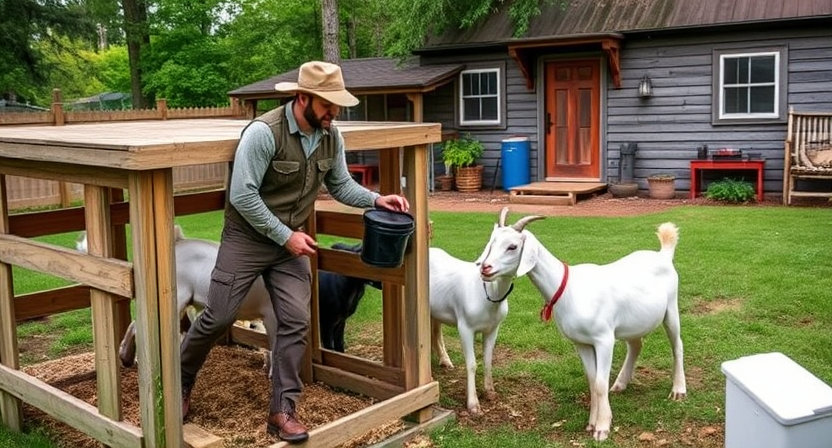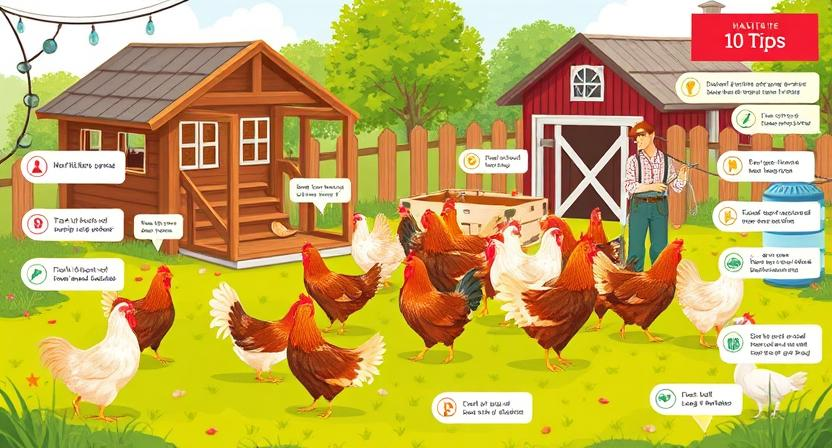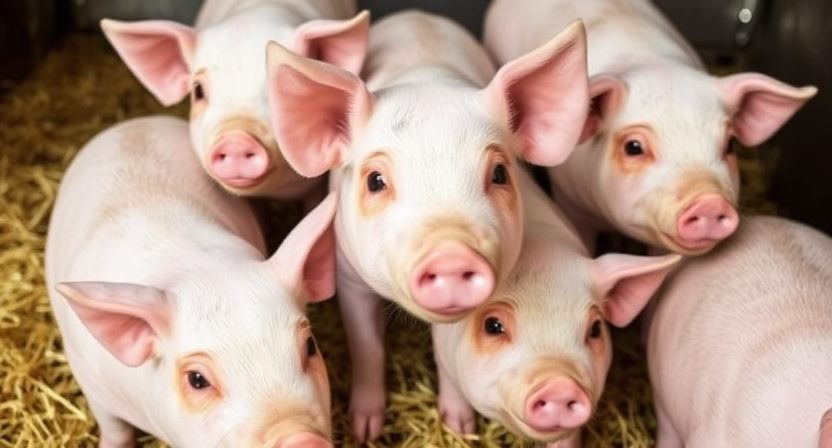How to Start with Backyard Goats: A Beginner’s Guide

Selecting the Right Breed of Goats

When selecting the right breed of goats for your farm or homestead, it is essential to consider your specific needs and goals. Different breeds offer unique characteristics that can align with various purposes such as milk production, meat, fiber, or even brush clearing. Conduct thorough research on the various goat breeds available in your area and their specific traits to determine which would best suit your requirements.
Factors to consider when choosing a breed include size, temperament, climate adaptability, and maintenance requirements. For example, if you are looking for a dairy breed, you may opt for Nubians or Saanens known for their high milk production. On the other hand, if meat production is your primary focus, Boer goats are a popular choice due to their fast growth rate and quality meat. By understanding the strengths and characteristics of different goat breeds, you can make an informed decision that aligns with your objectives and resources.
• Size
• Temperament
• Climate adaptability
• Maintenance requirements
When selecting a breed, it is also important to consider the availability of resources such as pasture space, shelter, and feed. Some breeds may require more extensive grazing areas or specialized diets to thrive. Additionally, certain goat breeds may have specific health considerations that need to be addressed through proper care and management practices.
Another crucial factor to keep in mind is your level of experience with goats. Some breeds are known for being more docile and easy to handle, making them ideal for beginners. Others may require more advanced knowledge and skills in goat husbandry. Consider your own capabilities and comfort level when choosing a breed that will best suit your farming or homesteading operation.
Lastly, don’t forget to take into account the long-term goals you have for your goat herd. Whether you are looking to expand your flock for commercial purposes or simply want a few goats as pets, selecting the right breed can set you on the path towards success. By carefully evaluating all these factors and doing thorough research, you can ensure that you choose a breed of goats that will meet your needs and bring enjoyment to your farm or homestead.
• Availability of resources
• Health considerations
• Level of experience
• Long-term goals
Researching Local Regulations and Zoning Laws

Before you embark on your goat keeping journey, it’s crucial to thoroughly research the local regulations and zoning laws in your area. Different cities and municipalities may have specific rules regarding the number of goats allowed, the type of fencing required, and the distance of the shelter from property lines. By understanding these regulations upfront, you can avoid potential fines and conflicts with neighbors.
Zoning laws also play a significant role in determining whether you can keep goats on your property. Certain zoning restrictions may prohibit agricultural activities in residential areas or have specific requirements for livestock keeping. Contact your local zoning authority or planning department to inquire about any relevant regulations that may impact your goat-keeping plans.
• It’s important to research local regulations and zoning laws before keeping goats
• Different cities may have specific rules regarding the number of goats allowed
• Zoning laws can also impact whether you can keep goats on your property
• Contact your local zoning authority or planning department for more information
Setting Up Proper Fencing and Shelter

When setting up fencing for your goat enclosure, it is essential to choose materials that are sturdy and secure. Fencing should be tall enough to prevent goats from jumping over and strong enough to withstand their natural inclination to rub and lean on it. Additionally, ensure that there are no gaps or spaces that goats could squeeze through, as they are known to be quite adept at escaping if given the opportunity.
In terms of shelter, goats require a structure that provides protection from the elements such as rain, wind, and extreme heat or cold. The shelter should be well-ventilated to prevent the buildup of moisture and ammonia from their waste. Make sure there is enough space for all your goats to comfortably seek refuge inside and that the flooring is easy to clean and maintain for their overall health and well-being.
• Choose sturdy and secure fencing materials
• Ensure fencing is tall enough to prevent jumping
• Fencing should be strong enough to withstand rubbing and leaning
• Check for gaps or spaces that goats could escape through
• Provide shelter from elements like rain, wind, heat, and cold
• Shelter should be well-ventilated
• Ensure there is enough space for all goats to seek refuge inside
• Easy-to-clean flooring for overall health and well-being of goats
Choosing the Right Feed and Nutrition Plan

When it comes to selecting the feed and nutrition plan for your goats, it’s essential to consider their specific dietary needs based on factors like age, breed, and purpose. A well-balanced diet typically consists of high-quality hay, grains, minerals, and fresh water. Consulting with a veterinarian or livestock nutritionist can help tailor a feeding program that meets the unique requirements of your goat herd.
In addition to providing a nutritious diet, it’s important to monitor the body condition score of your goats regularly. Adjusting their feeding regimen based on their condition, activity level, and any health issues can help prevent malnutrition or obesity. By understanding the nutritional needs of your goats and making informed choices about their feed, you can promote their overall health and well-being.
• When selecting feed for your goats, consider factors like age, breed, and purpose
• A well-balanced diet includes high-quality hay, grains, minerals, and fresh water
• Consult with a veterinarian or livestock nutritionist to tailor a feeding program
• Monitor the body condition score of your goats regularly
• Adjust feeding regimen based on condition, activity level, and health issues to prevent malnutrition or obesity.
Establishing a Routine for Feeding and Care

Feeding and care routines are crucial for the health and wellbeing of your goats. When establishing a routine, consistency is key to ensure your goats receive the proper nutrition and attention they require. It is important to feed your goats at the same time each day, providing them with a balanced diet that meets their nutritional needs. Additionally, regular health check-ups and grooming should be incorporated into your routine to monitor their well-being and maintain their overall health.
• Feeding goats at the same time each day helps maintain their digestive health and prevents overeating
• Providing a balanced diet with proper nutrients such as hay, grains, and fresh water is essential for their overall well-being
• Regular health check-ups by a veterinarian can help detect any potential issues early on and prevent illnesses
• Grooming your goats regularly, including trimming hooves and brushing coats, can prevent matting and infections
Establishing a routine for feeding and care not only benefits the goats but also helps you as a caregiver to stay organized and proactive in managing their needs. By creating a schedule that includes feeding times, health checks, grooming sessions, and other necessary tasks, you can ensure that your goats are happy, healthy, and thriving. Remember to adjust the routine as needed based on seasonal changes or individual goat requirements to provide them with the best possible care.
Understanding Basic Health and Wellness Needs

Ensuring the health and wellness of your goats is essential for their overall well-being. Regularly checking for signs of illness, such as changes in appetite or behavior, can help you detect any issues early on. Providing a clean and dry living environment, along with access to fresh water and proper nutrition, is key to maintaining their health.
Routine vaccinations and deworming are crucial in preventing common illnesses and parasites. Consulting with a veterinarian to establish a comprehensive healthcare plan and schedule can help ensure that your goats stay healthy. Additionally, keeping a close eye on their weight, hoof health, and dental condition is important for their overall wellness.
• Regularly check for signs of illness such as changes in appetite or behavior
• Provide a clean and dry living environment
• Ensure access to fresh water and proper nutrition
• Schedule routine vaccinations and deworming
• Consult with a veterinarian for a comprehensive healthcare plan
• Monitor weight, hoof health, and dental condition regularly
Learning How to Handle and Milk Goats

When it comes to handling and milking goats, proper techniques and gentle handling are essential for both the well-being of the animals and the quality of the milk produced. Begin by approaching goats calmly and confidently, using slow movements to avoid spooking them. Establishing a bond of trust through consistent interaction and positive reinforcement can make the milking process easier and more enjoyable for both you and your goats.
When it’s time to milk, ensure your goats are comfortably positioned in a stanchion or milking stand. Gently clean their udders with a mild cleansing solution to prevent contamination of the milk. Use a steady, rhythmic motion while milking to encourage the flow of milk and prevent any discomfort for the goats. Proper hygiene practices during milking and efficient milk storage are crucial for maintaining the quality and safety of the milk for consumption.
• Approach goats calmly and confidently
• Use slow movements to avoid spooking them
• Establish a bond of trust through consistent interaction
• Clean udders with mild cleansing solution before milking
When it’s time to milk, ensure your goats are comfortably positioned in a stanchion or milking stand. Gently clean their udders with a mild cleansing solution to prevent contamination of the milk. Use a steady, rhythmic motion while milking to encourage the flow of milk and prevent any discomfort for the goats. Proper hygiene practices during milking and efficient milk storage are crucial for maintaining the quality and safety of the milk for consumption.
By following these proper techniques for handling and milking goats, you can ensure that both you and your animals have a positive experience during the process. Remember that gentle handling, establishing trust, cleanliness, and proper hygiene practices are key factors in producing high-quality goat milk. With patience and practice, you can become proficient in caring for your goats and harvesting their nutritious milk effectively.
Introducing New Goats to Your Herd

When introducing new goats to your existing herd, it’s essential to follow a gradual and controlled process to minimize stress and potential conflicts. One recommended approach is to initially separate the new goats in a designated quarantine area for a period of time to observe their health and behavior, as well as prevent the spread of any contagious diseases. During this time, ensure that the new goats have access to clean water, proper nutrition, and shelter.
After the quarantine period, gradually introduce the new goats to members of your existing herd in a neutral space to allow for initial interactions and establish a hierarchy. Monitor their interactions closely for any signs of aggression or dominance displays, as well as ensure that all goats have enough space and resources to prevent competition and bullying. Providing ample feeding stations and keeping an eye on their body language can help you gauge how well the integration process is going and make any necessary adjustments to ensure a smooth transition.
• Gradually introduce new goats to existing herd in neutral space
• Monitor interactions for signs of aggression or dominance displays
• Ensure all goats have enough space and resources to prevent competition
• Provide ample feeding stations and monitor body language for integration progress
Managing Waste and Keeping the Area Clean

Proper waste management is essential when raising goats to maintain a clean and healthy environment. Goats produce a significant amount of manure daily, and it should be promptly removed from living areas to prevent the spread of disease and parasites. Regularly cleaning out barns, pens, and feeding areas helps reduce odors and contamination, creating a more comfortable setting for both the goats and the caretakers.
In addition to cleaning out manure, keeping the area clean involves regular maintenance and sanitization of water troughs and feeding equipment. Water should be fresh and free of debris, and feeders should be cleaned regularly to prevent the buildup of mold and bacteria. Providing a clean environment not only promotes the overall health and well-being of the goats but also makes daily chores more manageable and enjoyable for the caregiver.
• Proper waste management is essential when raising goats
• Goats produce a significant amount of manure daily
• Manure should be promptly removed to prevent disease and parasites
• Regular cleaning of barns, pens, and feeding areas reduces odors and contamination
In addition to cleaning out manure, keeping the area clean involves regular maintenance and sanitization of water troughs and feeding equipment. Water should be fresh and free of debris, and feeders should be cleaned regularly to prevent the buildup of mold and bacteria. Providing a clean environment not only promotes the overall health and well-being of the goats but also makes daily chores more manageable and enjoyable for the caregiver.
Creating a Safe and Enriching Environment

To create a safe and enriching environment for your goats, it is essential to provide adequate shelter, clean water, and nutritious feed. Goats need a secure area to rest, especially during extreme weather conditions, so investing in sturdy fencing and a cozy shelter is crucial. Ensure that the fencing is high enough to prevent escapes and that the shelter is well-ventilated and free of drafts to keep your goats comfortable.
In addition to physical needs, goats also thrive in environments that offer mental and physical stimulation. Providing enrichment activities such as climbing structures, toys, and access to different areas to explore can help keep your goats engaged and prevent boredom. Rotating grazing areas and incorporating natural elements like logs and rocks can also contribute to a stimulating environment that promotes your goats’ well-being.
• Providing adequate shelter, clean water, and nutritious feed is essential for creating a safe environment for goats
• Invest in sturdy fencing and a cozy shelter to ensure goats have a secure area to rest, especially during extreme weather conditions
• Ensure that fencing is high enough to prevent escapes and shelter is well-ventilated to keep goats comfortable
• Enrichment activities such as climbing structures, toys, and access to different areas can help keep goats engaged and prevent boredom
• Rotating grazing areas and incorporating natural elements like logs and rocks can contribute to a stimulating environment for goats
Monitoring Behavior and Social Dynamics

Monitoring behavior and social dynamics within your goat herd is crucial for maintaining a harmonious and healthy environment. Pay close attention to how goats interact with each other, noting any signs of aggression, dominance, or isolation. Observing their body language, vocalizations, and overall demeanor can provide valuable insights into their social hierarchy and well-being.
It’s important to intervene if any conflicts arise between goats, as unchecked aggression can lead to injuries and stress within the herd. Provide ample space and resources for all goats to prevent competition and ensure a peaceful coexistence. By actively monitoring their behavior and addressing any social issues promptly, you can promote a positive and thriving herd dynamic.
• Pay close attention to how goats interact with each other
• Note any signs of aggression, dominance, or isolation
• Observe their body language, vocalizations, and overall demeanor
• Intervene if conflicts arise between goats
• Provide ample space and resources for all goats
• Address social issues promptly to promote a positive herd dynamic
Preventing and Treating Common Illnesses

Goats, like any other animal, are susceptible to a range of common illnesses that can impact their health and well-being. Being proactive about preventing these illnesses is key to maintaining a thriving herd. Regularly scheduled vaccinations and deworming treatments, as recommended by a veterinarian, can help prevent many common illnesses. Additionally, providing a clean and dry environment, along with a balanced diet rich in essential nutrients, can boost their immune system and reduce the risk of infections.
In the unfortunate event that one of your goats falls ill, swift action is crucial to their recovery. Recognizing the early signs of illness, such as changes in behavior, appetite, or physical appearance, is essential. It’s important to have a working relationship with a veterinarian who is knowledgeable about goat health and can provide prompt and accurate diagnosis and treatment. Always follow their recommendations closely and monitor the sick goat closely for any improvements or worsening symptoms.
• Regularly scheduled vaccinations and deworming treatments can prevent common illnesses
• Providing a clean and dry environment can boost the immune system
• Balanced diet rich in essential nutrients reduces the risk of infections
In case a goat falls ill:
• Recognize early signs of illness like changes in behavior, appetite, or physical appearance
• Have a working relationship with a knowledgeable veterinarian
• Follow their recommendations closely for prompt and accurate diagnosis and treatment
• Monitor the sick goat closely for improvements or worsening symptoms
Developing a Breeding Plan, If Desired

Breeding goats can be a rewarding endeavor for those looking to expand their herd or improve specific traits within their goat population. When developing a breeding plan, it is essential to establish clear goals and priorities. Consider what characteristics you want to enhance or maintain in your goats, such as milk production, meat quality, or temperament. Research different breeding techniques and genetic lines to determine the best matches for achieving your desired outcomes.
Once you have identified your breeding goals, it is crucial to track the lineage and health history of your goats. Keep detailed records of breeding dates, parentage, and any health issues that may arise. This information will not only help you make informed breeding decisions but also contribute to the overall health and well-being of your herd. Be prepared for the time and resources that breeding requires, as it is a long-term commitment that can have a significant impact on your goat operation.
• Establish clear goals and priorities for breeding goats
• Consider traits such as milk production, meat quality, and temperament
• Research different breeding techniques and genetic lines for desired outcomes
• Track lineage and health history of your goats
• Keep detailed records of breeding dates, parentage, and health issues
• Make informed breeding decisions based on collected information
• Be prepared for the time and resources required for breeding
• Understand that breeding is a long-term commitment with significant impact on goat operation
Implementing Sustainable Practices

Sustainable practices are essential for the long-term well-being of your goat farm. By implementing strategies that minimize environmental impact and promote resource conservation, you can create a more resilient and eco-friendly operation. One key aspect of sustainability is ensuring proper pasture management. Rotational grazing, where goats are moved regularly to fresh grazing areas, can help prevent overgrazing, promote soil health, and reduce the risk of parasite infestations.
Additionally, incorporating natural remedies and preventative measures can reduce the reliance on chemical inputs and antibiotics, promoting the overall health of your goats and the environment. Utilizing herbal supplements, essential oils, and holistic healthcare practices can support the immune system of your goats and reduce the need for synthetic medications. Embracing sustainable practices not only benefits your farm but also contributes to a more ethical and environmentally conscious approach to goat keeping.
• Rotational grazing helps prevent overgrazing and promotes soil health
• Reduces risk of parasite infestations
• Incorporating natural remedies reduces reliance on chemical inputs and antibiotics
• Herbal supplements, essential oils, and holistic healthcare practices support immune system of goats
• Embracing sustainable practices benefits farm and contributes to ethical goat keeping
Connecting with Local Goat Owners and Resources

Reaching out to local goat owners can be a valuable resource for new goat enthusiasts. Connecting with seasoned breeders allows you to tap into their wealth of knowledge and experience in raising and caring for goats. These connections can offer insights on best practices, problem-solving tips, and even potential mentorship opportunities as you navigate the world of goat farming.
Local goat owners may also be part of a wider network or community that can provide additional resources and support. These networks often organize events, workshops, and gatherings where you can learn from other goat enthusiasts, exchange ideas, and build relationships within the goat farming community. By connecting with local goat owners and resources, you not only gain access to valuable information but also foster a sense of camaraderie and belonging in a shared passion for raising and caring for these amazing animals.
• Local goat owners can provide valuable knowledge and experience in raising goats
• They can offer insights on best practices and problem-solving tips
• Connecting with local goat owners may lead to potential mentorship opportunities
• Local goat owners may be part of a wider network or community that provides additional resources and support
• These networks often organize events, workshops, and gatherings for learning and networking within the goat farming community
Investing in Necessary Equipment and Supplies

Investing in necessary equipment and supplies for your goat farm is crucial for ensuring the health and well-being of your animals. Some essential items to consider purchasing include feeders, water troughs, hoof trimmers, grooming supplies, milking equipment, and appropriate medical supplies for basic care. It is important to invest in high-quality items that are durable and suitable for the specific needs of your goats.
Additionally, having a reliable source of hay, grains, and mineral supplements is essential for providing proper nutrition to your herd. Proper storage containers for feed and supplies will help maintain freshness and prevent contamination. Investing in equipment such as a shelter, fencing materials, and sturdy gates is essential for creating a safe and secure environment for your goats. Lastly, having a backup power source, such as a generator, can be invaluable during emergencies or power outages to ensure the well-being of your animals.
– Feeders
– Water troughs
– Hoof trimmers
– Grooming supplies
– Milking equipment
– Appropriate medical supplies for basic care
Having a reliable source of:
– Hay
– Grains
– Mineral supplements
Investing in proper storage containers for feed and supplies to:
– Maintain freshness
– Prevent contamination
Equipment such as:
-Shelter
-Fencing materials
-Sturdy gates
Backup power source like a generator for emergencies or power outages.
Educating Yourself on Goat Behavior and Communication

Goats are known for their social nature and unique behaviors that communicate their needs and feelings. Understanding goat behavior is key to building a strong bond with your animals and meeting their physical and emotional needs. Observing how goats interact with each other, their body language, vocalizations, and habits can provide valuable insight into their well-being.
Communication with goats involves more than just verbal cues; goats are highly perceptive to non-verbal signals and gestures. Establishing trust and respect through consistent communication can help create a harmonious relationship between you and your goats. By learning to interpret their cues and responding appropriately, you can effectively address any issues, build trust, and enhance your overall experience as a goat owner.
• Observing how goats interact with each other can provide insight into their social structure and relationships
• Understanding goat body language, such as tail wagging or ear position, can help you gauge their mood and emotions
• Recognizing different vocalizations, like bleating or baaing, can indicate various needs or feelings in goats
• Pay attention to habits like grazing patterns or scratching behavior to understand your goat’s daily routine and preferences.
Preparing for Seasonal Changes and Challenges

When it comes to raising goats, it is essential to prepare for the various seasonal changes and challenges that may arise throughout the year. Each season brings its own set of considerations when it comes to caring for your goats and ensuring their health and well-being. From extreme temperatures in the summer to harsh weather conditions in the winter, it is important to have a plan in place to address these challenges effectively.
During the hot summer months, it is crucial to provide adequate shade and access to fresh, cool water to help your goats stay hydrated and comfortable. Consider installing fans or misters in their shelter to help them stay cool during heatwaves. In the winter, make sure your goats have a draft-free shelter with plenty of bedding to keep them warm. Additionally, provide them with extra calories in their diet to help them maintain their body heat during the colder months. By planning ahead and making adjustments based on the season, you can ensure that your goats are happy and healthy year-round.
– Provide adequate shade and fresh, cool water during hot summer months
– Consider installing fans or misters in shelter to help goats stay cool
– Ensure draft-free shelter with plenty of bedding for warmth in winter
– Provide extra calories in diet to help goats maintain body heat during colder months
Considering the Financial and Time Commitment

Raising goats can be a fulfilling endeavor, but it’s essential to consider the financial and time commitments involved. Goats require daily care, attention, and maintenance, making it a time-intensive responsibility. From feeding and milking to monitoring their health and wellbeing, raising goats demands a significant investment of time.
In addition to the time commitment, aspiring goat owners should also be prepared for the financial aspect of raising these animals. Costs associated with goats include purchasing the initial herd, fencing and shelter construction, veterinary care, feed and supplements, and other essential supplies. It’s crucial to create a budget and financial plan to ensure that you can provide proper care for your goats without experiencing financial strain. Be prepared for unexpected expenses and fluctuations in costs, as goat ownership can require a consistent financial investment.
• Raising goats requires daily care, attention, and maintenance
• Time-intensive responsibility including feeding, milking, and monitoring health
• Significant investment of time needed to raise goats
• Financial aspect of raising goats should be considered
• Costs include purchasing initial herd, fencing/shelter construction, veterinary care, feed/supplements
• Creating a budget and financial plan is crucial for proper care without financial strain
• Be prepared for unexpected expenses and fluctuations in costs
• Consistent financial investment required for goat ownership
Celebrating Milestones and Successes

As a goat owner, celebrating milestones and successes along the way is an important aspect of your journey. Whether it’s your goats successfully kidding, reaching a certain production goal, or simply thriving in their environment, taking the time to acknowledge and appreciate these achievements can boost morale and strengthen your connection with your animals. Consider marking these moments with a small celebration, such as a special treat for your goats or a moment of reflection on how far you’ve come in your goat-keeping experience.
Remember to also celebrate your own accomplishments as a goat owner. Learning how to care for and manage a herd of goats is no small feat, so give yourself credit for the knowledge and skills you’ve gained along the way. Take pride in the hard work you’ve put in, whether it’s in building a strong and healthy herd, overcoming challenges, or simply finding joy in the daily interactions with your goats. By recognizing your own growth and progress, you can continue to be motivated and inspired in your goat-keeping journey.
• Celebrating milestones and successes is crucial for goat owners
• Acknowledge achievements like successful kidding or reaching production goals
• Boost morale and strengthen connection with your goats through celebrations
• Consider giving special treats to your goats or reflecting on your journey together
Remembering to celebrate your own accomplishments as a goat owner is just as important.
Learning how to care for and manage a herd of goats is no easy task, so be proud of the knowledge and skills you have acquired.
Give yourself credit for building a healthy herd, overcoming challenges, and finding joy in daily interactions with your goats.
Recognizing your growth can keep you motivated and inspired in your goat-keeping journey.




